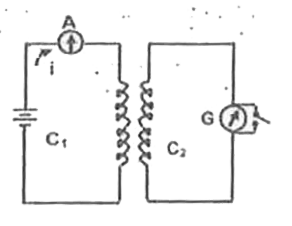The coil employed in a experiment similar to that of Stewart and Tolman has a diameter d=500 mm and N=400 turns of copper wire. The moment the coil stops it is connected through a pair of sliding contacts to a ballistic galvanometer Fig. The total circuit resistance is R-50 ohm. The coil is rotated at a constant speed of n=6000 r.p.m. and quickly brought to a halt, the charge passing through the galvanometer being Q=1.1×10−8C. Find the specific charge of the charge carriers in copper.

The correct Answer is:qm=π2d2nNQR=1.8×1011C/kg
Similar Questions
A small cylindrical magnet M (Fig) is placed in the centre of a thin coil of radius a consisting of N turns. The coil in connected to a ballistic galvanometer. The active resistance of the whole circuit is equal to R. Find the magnetic moment of the magnet if its removel from the coil results in a charge q flowing through the galvanometer.

View SolutionA current coil of total resistance R is kept inside magnetic field. How is the change in magnetic flux through the coil related to the amount of charge passing through the coil?
View Solution
Knowledge Check
A circular coil of diameter 7 cm has 24 turns of wire, carrying current of 0.75 A. The magnetic moment of the coil is
A6.9×10−2A−m2B2.3×10−2A−m2C10−2A−m2D10−3A−m2A circular coil of diameter 7cm has 24 turns of wire carrying current of 0.75A. The magnetic moment of the coil is
A6.9×10−2amp−m2B2.3×10−2amp−m2C10−2amp−m2D10−3amp−m2One coil of resistance 40Ω is connected to a galvanometer of 16Ω resistance . The coil has radius 6mm and turns 100. This coil is placed between the poles of a magnet such that magnetic field is perpendicular to coil. If coil is dragged out then the charge through the galvanometer is 32μC. The magnetic field is :-
A6.55 TB5.66 TC0.655 TD0.566 T
A current-carrying coil of total resistance R is kept inside magnetic field. How is the change in magnetic flux through the coil related to the amount of charge passing through the coil ?
View SolutionIn figure when key is pressed the ammeter A reads i ampere . The charge passing in the galvanometer circuit of total resistance R is Q . The mutual inductance of the two coils is

View SolutionA flat circular coil of 200 turns of diameter 25 cm is laid on a horizontal table and connected to a ballistic galvanometer. The complete circuit is having resistance of 800Ω. When the coil is quickly turned over, the spot of light swings to a maximum reading of 30 divisions. When a 0.1μF capacitor charged to 6 V is discharged through the same ballistic galvanometer, a maximum reading of 20 division is obtained. Calculate the vertical component of the earth's magnetic induction.
View SolutionThe coil of a suspended coil galvanometer has a very high resistance when a momentary current is passed through the coil. It
View SolutionIn figure when key is pressed the ammeter A reads i ampere . The charge passing in the galvanometer circuit of total resistance R is Q . The mutual inductance of the two coils is

View Solution
